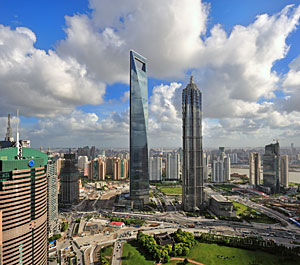Although 2008 brought a financial crisis that stretched unemployment rolls and slowed production lines across the globe, it was a superlative year for skyscrapers. According to a recent study by the Council on Tall Buildings and Urban Habitat (CTBUH), more tall buildings—and taller ones—were completed in 2008 than ever before. The council expects 2009 to be another record year.

The Shanghai World Financial Center, by KPF, was completed last year.
The CTBUH study, released at the end of January, reports that the concurrence of failing financial markets and skyscraper grand openings is not unusual—rather it results from what Philip Oldfield, a co-author of the report, calls “a lag effect.” Because buildings take years to move from conception to construction to completion, those begun at the apex of the market often are finished at its nadir.
The study also found that, beyond rising heights, current and future trends in tall building include a material shift from steel to concrete, a programmatic shift from office to mixed-use and residential, and a geographic shift from North America to Asia and the Middle East.
The study predicts that we will start to see a dip in the completion of supertall towers in 2011, with the average height of the ten tallest skyscrapers finished in the following few years dropping by as much as 300 feet. “But as the world comes out of the recession,” says Oldfield, “figures suggest that height will again start to break records.”
What accounts for the supertall trend? Oldfield partly attributes it to a growing interest in sustainability. Noting that denser cities are becoming widely accepted as essential to the prevention of climate change, he says, “high tall buildings are an integral part of creating that density.” He adds that other drivers include rising land prices, which make height an economic necessity, and public perception. “Tall buildings are global icons,” he says, and can catapult cities and whole countries into the global arena.
Terence Riley, curator of the 2004 Tall Buildings exhibition at the Museum of Modern Art in New York, agrees and suggests that Americans in particular “can look to the skyscraper as a truly American invention.” The world’s first skyscraper is considered by most to be William Le Baron Jenney’s 1885 Home Insurance Building in Chicago. “I think there’s a kind of pride and awe in the technology that is not totally misplaced,” adds Riley.
From the 1,250-foot Empire State Building completed in 1931 to the 1,614-foot Shanghai World Financial Center completed just last year, examples of such iconic skyscrapers abound. Soon to join the list are two buildings by Skidmore Owings and Merrill: the 1,776-foot World Trade Center One in New York, expected to be finished in 2012, and the Burj Dubai, expected to top out in the fall of 2009 (the firm is not revealing a specific date) at over 2,600 feet.
Another iconic, although not supertall, design promises to come from HOK New York: it recently unveiled plans for its 50- and 42-story (495- and 558-foot) Twisting Towers in Songdo International Business District in South Korea. Construction of the LEED certification–seeking towers is scheduled to begin in July of 2009 and end by the close of 2012. Reflecting on why clients, developers, and architects like to build supertall, the firm’s design director, Kenneth Drucker, AIA, suggests it is because having the tallest building is “a symbol of strength.”
Of course, the tallest building in the world can only be a symbol of strength or status if it reaches completion. Reports of halted projects suggest some supertall buildings may never make it that far. Among the projects put on hold at the end of 2008 were Santiago Calatrava’s Chicago Spire, two Norman Foster projects—the Russia Tower in Moscow and the U2 Tower in Dublin, which would have been Ireland’s tallest—and several projects in Dubai including the Burj al Alam by Nikken Sekkei Ltd. The Torre Gran Costanera by Pelli Clarke Pelli in Chile is the latest building to fall victim to the global economic crisis: the BBC reported at the end of January that construction has stopped on what was to be, at 985 feet, the tallest office tower in South America.



Post a comment to this article
Report Abusive Comment